Character Charts
Character Charts
One thing that always gets me excited to start a new writing project is creating a character. Creating a new character is a sure-fire way to amp your self up about your new story.
There is no write or wrong way to create them, you just do!
However, creating a new name and face for a story can be daunting, particularly when it comes to naming the character! I like to choose a name with a special meaning or connection to the story I have in mind.
I find it very helpful to refer to a ‘character development’ chart or ‘character features’ charts.
I'll post some helpful charts down below! I hope this helps :)




More Posts from Lune-versatile and Others
how to write relatable characters
writing relatable characters may seem like an easy task, especially when you’re constructing your protagonist. but what if you want to make your antagonist likeable? what if you want people to hate your protagonist but still root for them? all of this and more requires that your characters be relatable. they need to feel real, so how do you do that? here’s how:
- flaws: this is probably obvious. everyone has flaws, so we should give our characters flaws, too. this applies even if your character is non-human; they cannot escape the personification that we as writers or readers project onto them. we are humans reading, so we expect to see human qualities everywhere we look. if you’re having trouble of identifying your character’s flaws, here are some prompts for ways to think about flaws beyond a list:
what skills do they lack? what do they struggle with?
can their strengths be turned against them as a weakness?
what makes them react emotionally or impulsively?
are they aware of their flaws? if so, do they want to improve them or change them?
- quirks: these are what make your character unique or special, and no, i don’t mean purple eyes or unique physical traits. i mean: what makes your character authentically themselves? what traits define them that few others have? some ways to think about this are:
how do they react when nervous? do they have a tell? similarly, how do they react on behalf of any emotion?
what skills do they have that hardly anyone else has?
what obscure thing are they obsessed with?
do they have a unique outlook on life compared to their peers?
- values: these come from life experiences: where we were raised, our family and friends, our community, religious affiliations, etc. i suggest identifying eight to ten values that define your character and then narrowing that list down to five values that mark their core or essence. think about how these values influence their choices, decisions, and ultimately, the plot of the novel. here are some more prompts to think about values:
how do they react when their values are challenged? are they one to speak up or do they sit back in the shadows?
what, if anything, will change or shatter their values?
are their actual values misaligned with their believed values?
- stakes: what is at risk for your character? what is motivating them? stakes don’t need to be over the top or life or death; they can be as simple as maintaining a relationship or reaching a goal. unless there’s an outside influence (ie. percy’s mother being kidnapped in The Lightning Thief), most stakes—especially those relatable—tie back to values. even those influenced by outside factors can tie back to values: the only reason percy is motivated to get his mother back is because he cares for her and she is the one person who has always advocated for him and cared for him. he values family and riordan uses his family to motivate him and incite the plot. generally, there will be one overarching stake for your character, but throughout your novel, there should be several smaller stakes. these may not service the plot but should elaborate on your character nonetheless. some ways to think about stakes include:
how can i use internal or external factors to create convincing, relatable stakes that tie back to basic values?
why does the overarching stake matter to my character? why do they care?
how can i raise the stakes or introduce new ones that are relevant to my character and illustrate them as a relatable being?
- connection: even if your character is an introvert, they will still be connected to someone, something, or even an idea. we, as humans, look to certain people, pets, objects, and ideas to maintain our sense of reality whether we realize it or not. if your character prides themselves in having no attachments, think about the ideas or themes that mark the cornerstones of their reality. most human beings strive for some form of connection, so here are more prompts for thinking about your characters and connection:
what does connection mean to my character? how do they show how they value their connections or relationships?
how does my character’s behavior change when around different connections?
what connections define my character and their reality? how will these connections influence my character and/or the plot?
how will removing or challenging a connection change, influence, or motivate my character?
a good rule of thumb is to treat a character as a human, not a plot device. there is a time or place in which a character must act as a plot device, but if you’re wanting your readers to be compelled by your narration and the characters within them, you should strive to write your characters as human (aka as relatable). one of the greatest pleasures i find in writing is when other’s identify themselves in my writing.
you’re not just here to tell a story, you’re here to connect with others through the illustration of your characters. let the reader navigate your prose as a detective, to search for and identify the evidence provided by you. that is to say, show us how these things manifest in your character. don’t tell us.
happy writing! hopefully this post gave you some ways to start thinking about how to show the relatability of your character. if you have any questions about implementing these tools or about writing characters, our ask box is always open.
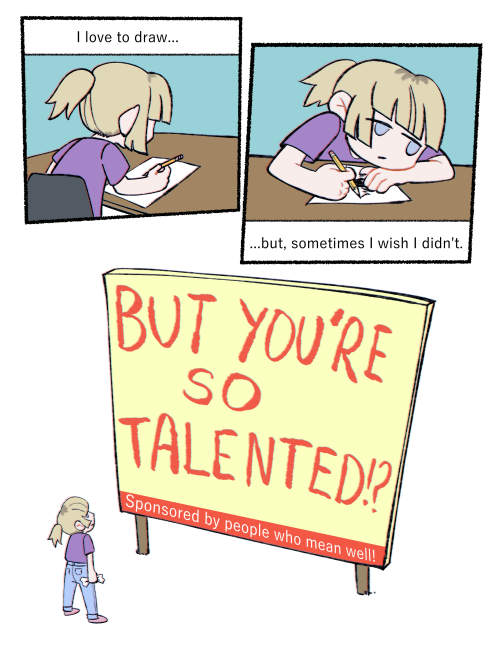
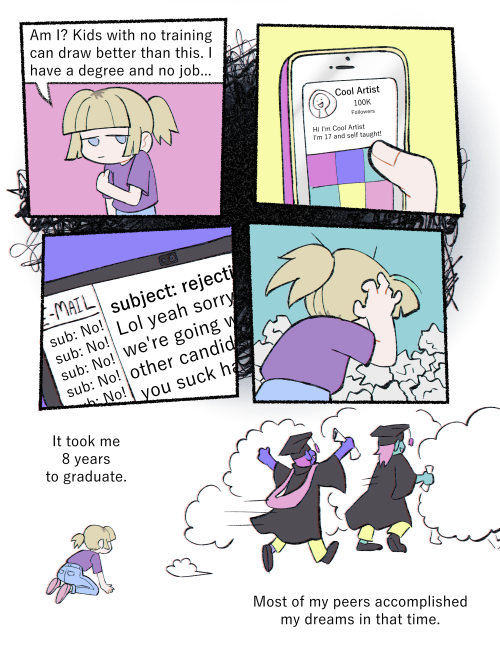
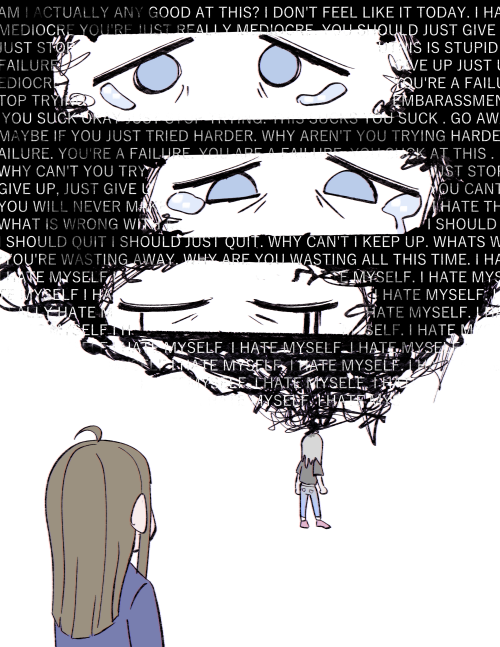
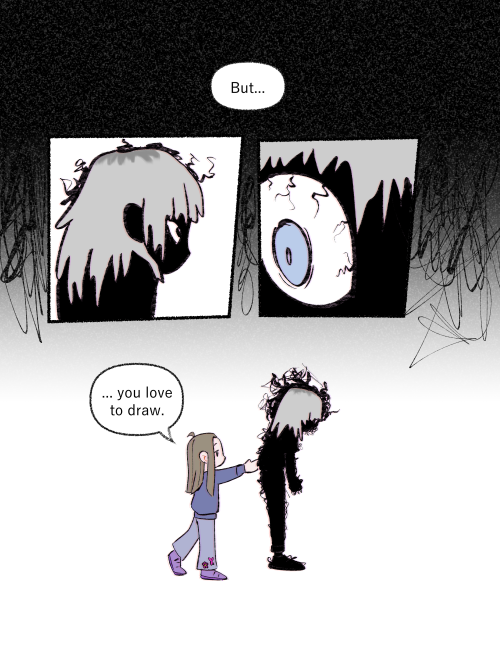
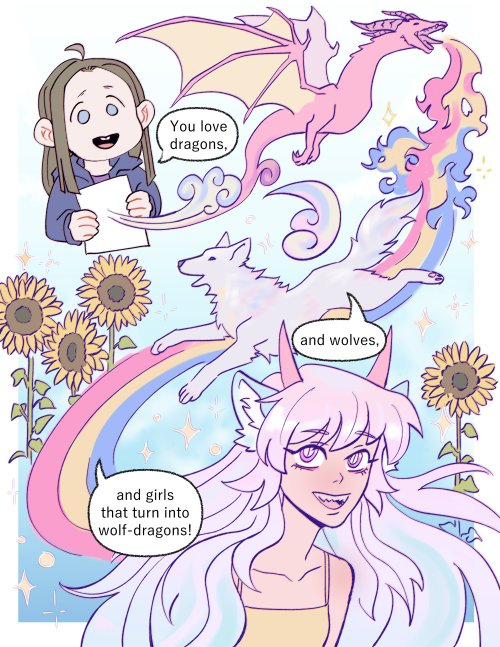
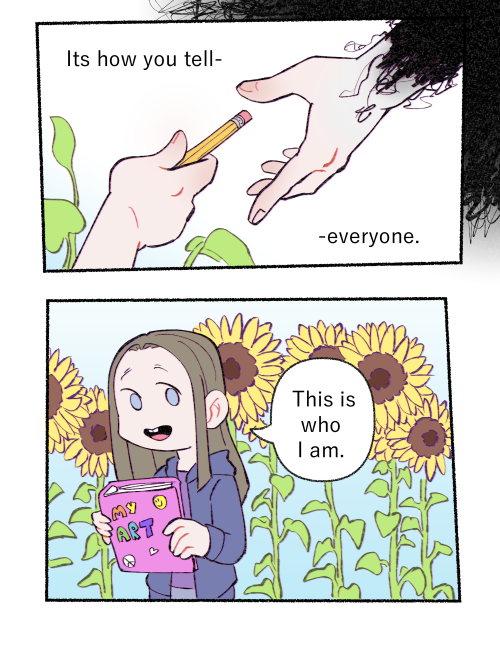

A comic to try and sort through some difficult feelings about being an artist and a reminder to not forget who you are.
how can I make my writing more atmospheric?
How to Make Your Writing More Atmospheric
The key to making your writing more atmospheric is adding more description, and the key to good description is to create sensory descriptions by utilizing things that can be seen, heard, touched/felt, tasted, and smelled. For example, if your character is watching a building burn, you could describe the color of the flames, the sound of sirens or crackling fire, the smell of smoke, the taste of charred wood in the air, the heat emanating from the flames. You don't need to (and shouldn't) hit on all the senses in every description, but every time you need to describe something, consider it from your character's POV... what do they see, smell, hear, taste, etc., then choose a few that make the thing being described the most real to your reader. The following posts will also help:
How to Make Your Description More Vivid
Adding Description to Your Writing
Describing Character Appearance and Clothing
Horror by Darkness (general description advice)
Horror by Daylight (general description advice)
Adding Emotional Details to a Horror/Tragedy Scene
An aye-write guide to Showing vs. Telling
I’ll bet that if you’ve ever taken an English class or a creative writing class, you’ll have come across the phrase “Show, don’t tell.” It’s pretty much a creative writing staple! Anton Chekov once said “ Don’t tell me the moon is shining. Show me the glint of light on broken glass.” In other words, showing should help you to create mental pictures in a reader’s head.
Showing helps readers bond with the characters, helps them experience the emotions and action more vividly, and helps immerse them in the world you have created. So “show, not tell” is definitely not bad advice - in certain circumstances. But it has its place. More on that later.
So How do I Show?
Dialogue
Thoughts/Feelings
Actions
Visual Details
So instead, of telling me “He was angry”, show me how his face face flushes red, how his throat tightens, how he slams his fist, how he raises his voice, how his jaw clenches, how he feels hot and prickly, how his breathing gets rapid, how his thoughts turn to static, etc.
Instead of telling me “The cafeteria was in chaos”, you could show me someone covered in food and slowly turning crimson, children rampaging under the feet of helpless adults, frenzied shouting, etc.
Handy Hint! Try to avoid phrases like “I heard”, “I felt”, “I smelled”, etc. These are still “telling words” (also known as filters) and may weaken your prose, as your readers could be taken out of the experience and you may lose their attention.
Is Showing Always The Right Thing to Do?
No! Absolutely not! Showing is not always right and telling is not always wrong! It’s important to develop the skill and instinct to know when to use showing and when to use telling, as both can be appropriate in certain occasions.
So, “Show, don’t tell” becomes “Show versus tell”.
What is Showing and Telling?
Showing is “The grass caressed his feet and a smile softened his eyes. A hot puff of air brushed past his wrinkled cheek as the sky paled yellow, then crimson, and within a breath, electric indigo”
Telling is “The old man stood in the grass and relaxed as the sun went down.”
Both of these excerpts are perfectly acceptable to use in your writing! But both do different things, although their meanings are pretty much the same. The first example is immersive, sweeping, visual, engaging. The second example is much more pared back and functional. But both have their places in prose!
Telling is functional. Think about when you tell people things. You tell your children dinner is ready. The news reporter tells you there’s a drop in crime rates. Your best friend tells you she’ll be late because her car broke down on the way to yours. These are brief and mundane moments in everyday life.
So, do these deserve multiple paragraphs with sensory detail and action/feeling/thought for every little thing? Do you need to spend an entire paragraph agonising over a minor detail when there’s a sword dangling (physically or metaphorically) over your MC’s head? No. And I’ll explain why.
When To Use Telling
As before, telling is functional. It’s brief. It’s efficient. It gives a gist of a situation without getting bogged down in detail.
Showing is slow, rich, expansive, and most certainly not efficient!
Here’s an example of some telling:
“Years passed, and I thought of Emily less and less. I confined her to some dark dusty corner of my brain. I had to elbow my memories of her to the side. I was too busy with other things. Finishing school, then university a year later. Life was full and enjoyable. But then, one dark cold September night…”
You can’t show this example, unless you wanted to waste page after page of your MC waking up, going through everyday life, to get to the point your actual story started. If you do that, you will likely kill off any interest a reader would have in your novel and likely, your book itself.
Summing Up
Showing:
Should be used for anything dramatic
Uses thoughts, feelings, dialogue, action, and visual detail
Will likely be used more than telling
Telling:
Can be used for
Delivering factual information
Glossing over unnecessary details
Connecting scenes
Showing the passage of time
Adding backstory (not all at once!)
Worldbuilding with Psychology
I haven’t mentioned this before, but I’m close to graduating with a psychology degree. As I was organizing things to move back in at university, I came across some notes from my Developmental Psych class. Psychologist Urie Bronfenbrenner presented an ecological systems model of child development, which represents a dynamic model of how people develop psychologically depending on their environment. I realized this may be an interesting reference for writers as we consider worldbuilding.

The individual is at the center. Each level interacts with the others and may affect them in different ways and to different degrees at different times. The individual is at the center of the model and has inherent traits which are the result of genetics. The microsystem is the individual’s most immediate surroundings. These are the places and people they come into close contact with on a daily basis, including the home and peer groups. The way microsystems treat the individual influence them, but the behavior of the individual also influences how the microsystems react to them. The mesosystem is essentially comprised of links between microsystems - between home and school, between home and church, between family and peers. Active involvement between microsystems promotes harmony and a sense of like-mindedness. The exosystem consists of linkages between systems that do not directly influence the individual, but do so indirectly by influencing a microsystem. For instance, the parents’ workplaces influences the parents’ behavior in the presence of the individual. The macrosystem consists of more distant influences that still have a significant impact on the individual. These elements often include beliefs, values, and other aspects of culture. For instance, life in a country at war will influence an individual differently than life in a country at peace. The chronosystem simply incorporates the meaningful passage of time. What is in each system, how much it affects an individual, and how can all shift in time.
What does this have to do with worldbuilding?
One can relate Bronfenbrenner’s model to creating a fictional sense of place however one likes, but I’ve drawn some parallels between each level and a corresponding element in worldbuilding. The model looks something like this.

The Protagonist:
The main character (or characters) lies at the center of your worldbuilding. It is through their eyes, or over their shoulder, that the reader experiences the world in which your story is set. A strong sense of place is vital to telling a satisfying tale, and a great deal of it comes down to your protagonists. Like in the original model, the protagonist has certain inborn traits that are a result of nature, but are also influenced by nurture - the other systems, in this case. The world is reflected in the hearts, minds, and behaviors of the people who live in it, and the people are reflected in the world they populate.
The Supporting Cast:
These are the people the protagonists interacts with most, and it’s a two-way street of influence. Their behavior influences the protagonist, but the protagonist affects them as well. You can present a great deal of information about the world through the interactions between characters. The way your protagonist interacts with parents and siblings can reveal family structure and dynamics, and interactions with friends or coworkers can shine light on social classes, pastimes, or employment. What your characters do, how they do it, and how they speak or feel about it will reveal what is normal or not.
The Immediate Surroundings:
Where are all these interactions taking place? The actual physical locales in seen in your story have an impact on the way people behave, but don’t forget the direct effect of setting the scene. One behaves differently at school, as opposed to the mall - how can you use differences like this to portray societal norms and mores in your story? Additionally, the events and values of a world leave physical reminders, which may be as simple as smog over a city unconcerned by or incapable of controlling pollution. Perhaps there is graffiti in the streets leftover from social or political unrest. The remnants of a torn-down shrine or monument may reflect changing values, war, or persecution of certain religions or other groups. Living conditions can portray class differences. Possibilities are endless.
The Social Structure and Culture:
Social structure has ramifications on who can interact with whom and what’s considered appropriate. These rules may be very strict or much more informal. If there are rigorous separations in place according to class, an interaction between members of different status will be shocking to your characters. Speaking out against an elder coworker may have severe consequences, or employees may be under forced retirement deadlines - these differences reveal if old age is revered or looked down upon. What holidays do people celebrate, and how? What manners of speech or behavior are unique to the setting? Social norms will be reflected in the behavior of your characters, but the population is capable of changing those norms.
The Physical Setting:
The setting at large still has far-reaching influence on your story. The geography itself will determine a number of things about the setting, including the landscape, weather, physical resources available, methods of transportation and more. All of these things trickle down into each of the layers beneath it and leave their fingerprints. If transportation is unfavorable, how does this affect information and cultural exchange? How about the economy? The physical setting is an umbrella of elements which may change everything under it, even in small or indirect ways.
The Genre:
The genre determines, amongst a few other things, how much of each of the above is needed. In essence, genre can be your guide to where you should place your focus in worldbuilding. Fantasy and science fiction often call for a greater emphasis on the physical setting and cultures, while realistic fiction set in real-life places readers are likely to be familiar with is likely to need emphasis on the protagonist and supporting cast. Some genres, such as historical fiction, may need a more evenly balanced blend of each system. The plot structure itself will also have an influence. For instance, in a ‘pursuit’ plot, the ticking clock and pursuit itself are typically considered of more import than the characters, while ‘forbidden love’ plots are all about the people and culture.
Remember, as always, to mold writing advice to your work and not the other way around. The influence of one or more of these systems may be heightened or lessened, depending on the needs of your story, and they may interact differently, perhaps even from chapter to chapter. Thank you for reading, and I hope this can be a useful model for you to use as a springboard in some of your worldbuilding.



people have asked me how i draw eyes so i made an extremely slap-dash eye tutorial! this is simply about how i draw a simple neutral eye, nothing to do with expressions (that’s a whole other thing).
start with the horizontal guide on the face, to help place the eyes. put circles where the eyes will go!
adjust the circles into diamond shapes– i got this idea from sinix design on youtube, it’s very helpful and easier to see where the lids should end than with a circle.
draw the top lid/lash lines, leaving a bit of space at the top of the diamond. keep each eye in time with each other– drawing one whole eye first makes it harder to match the other one.
then the bottom lids. i usually try to do all the lid shapes with a single curved stroke each. keep it simple pals!
irises & pupils. sometimes i’ll draw filled-in black circles for the irises, to help figure out where to place them naturally!
lid creases, use the leftover diamond at the top as a loose guide for where to place them. remember that the lid curves around the eyeball.
make adjustments! things don’t always come out perfect immediately. i usually have to thicken the lash line (i like mine quite thick), move the bottom lid up or down, and sometimes resize a whole eye (easier on computer than traditional, i know!). if you’re on a computer make sure to flip your canvas often so you can see these little things ❤
and to practice, just doodle a lot of small eyes! keeping them small makes them easier and faster to finish, so you can focus on your strokes and playing around with shapes, tilt, lid space, all that. don’t worry about making the irises perfect circles/ovals or any of that, just try to capture the character. have fun!
please please please please reblog if you’re a writer and have at some point felt like your writing is getting worse. I need to know if I’m the only one who’s struggling with these thoughts
I'm not sure I can express this sentiment strongly enough, but I'm going to try via the medium of large bolded text.
Write what the fuck you want.
Write what makes you happy. Write what makes your soul sing. Write what fucks you up and makes you cry. Write what comforts you. Write what distracts you. Write what you want to read. Write what you want to watch.
Write what you want to dream about tonight.
Write what you can't get enough of. Write what you're completely obsessed with. Write what wakes you up at 4am and drags you out of bed because you can't stop thinking about what your characters are going to do next.
Write what turns you on, if that's your vibe. Write characters you're in love with and characters who inspire you and characters you want to be friends with and characters you fucking hate but oh my god they're so much fun.
Write about things you would sell your soul to do in real life and things you would never do in real life. Write about things that are happening right now and things that happened a thousand years ago and things that might happen in the future and things you wish could happen.
Write to get a publishing deal or to sell your books yourself or not to sell your books at all. Write for your friends or for strangers or for the people who reblog your posts on Tumblr and send you songs that remind them of your characters.
Write for yourself.
Fuck any system that tells you there's only one right way to create or one valid way to share your writing. Your story, the way you tell it, has so much value. Make people smile or piss people off or do both of those things because art is divisive and fascinating and beautiful.
Start writing. Keep writing. And write what the fuck you want.
Finish Your Drafts (please)
I have this really bad habit of getting most the way through a draft, seeing how it needs to change structurally and… starting a new one. I have countless unfinished drafts and shorts and written out ideas that haunt me with their cut off sentences and half paragraphs.
Here’s the part that sucks. Finishing a draft is always worth it. Always. No matter how messed up your beginning may be, how much you need to rework or change, how much just isn’t coming together. Get through to the end, even if you have to write a bunch of stuff you aren’t proud of to get there, get through to the end.
I learned more about my novel from one finished draft than I did from the five unfinished ones after it. You need to explore your ending, because your ending is the most important part of the entire piece.
This month we explored outlining and character arcs—all of that planning, all of that work we’ve put into this project leads up to the ending. The ending will tell you more about your direction and how the pieces you’ve tried to put together are working than anything else. It’s the one place you can’t hide. Either the ending wraps up how you want it to, or you need to go back to the drawing board.
I almost didn’t finish that one draft. I knew there was a huge gaping problem I hadn’t noticed before right in the middle and that I had to rework some stuff. I nearly stopped there, but I pushed forward instead. It was there that I discovered a large part of that problem was the ending I had planned. I was working towards the wrong thing, so of course the middle would fall apart.
You’ll be able to see your character arcs, your theme, your subplots, all of it needs to be addressed in the ending, so your ending is going to tell you what is working and what isn’t.
Push through to the finish line. Best case scenario you understand your work and process on a deeper level. Worst case, you have a finished draft—and that’s always something to be proud of.
Good luck! Happy end of February. Next month we’ll be talking about some other ways to create characters and voice, amongst other things. I’m looking forward to it!
How to Write Flashbacks More Effectively
Many of our favorite books include a flashback or two. They put the main story on pause and reveal things readers need to know, but how do authors decide when to use them?
These are a few tips I have about writing flashbacks effectively so you can feel confident about weaving them into your stories.
1. Create a Clear Trigger
When you walk into a kitchen and smell cookies baking in the oven, the smell might trigger a memory. Maybe it’s a happy memory of baking with your family or exchanging cookies with your friends during a holiday party.
You wouldn’t think about that memory in that exact moment without the sensory trigger. Flashbacks work the same way.
Give your character a specific trigger so it’s obvious they’re having a flashback. You shouldn’t only rely on making the flashback italicised or set off by page breaks. It will feel more expertly integrated if there’s a cause-and-effect relationship with the scene.
The trigger can also serve a purpose. Maybe your protagonist hears a car honking and has a flashback to their recent car accident. It could let the reader in on how the accident happened or what it was like. The sound being a trigger also shows readers that your protagonist hasn’t dealt with the emotional ramifications of that traumatic experience, so it’s still fresh and affecting how they live their life.
Remember, there should be a clear point of return when the flashback ends. It may not always be a second trigger, like your protagonist’s best friend calling their name. It could also be a sensory moment or experience within the flashback that makes the protagonist essentially wake up due to discomfort or becoming aware that it’s a memory.
2. Make It Plot Essential
Flashbacks are plot essential, meaning that they have to either do something for the reader or your protagonist (maybe both at the same time).
In the above example, reliving the car accident informs the reader about what the protagonist experienced before the story started.
A flashback about an ex-partner treated the protagonist in a previous relationship could motivate the protagonist to make a choice in their current relationship that they wouldn’t have otherwise. The choice propels the story in a new direction.
3. Get to the Point
It’s important to keep flashbacks brief. Readers are investing their time and energy into the story you’re telling, not the story that happened leading up to your plotline.
Extended flashbacks can also confuse readers. They may not understand when the flashback has ended, especially if the relived experience happened to your protagonist recently.
A few paragraphs to a page or two will likely be more than enough to get your flashback’s point across. If it runs longer, make a mental note to return to that particular scene when you’re in your editing phase.
-----
Flashbacks can be effective storytelling tools, but use these tips to avoid relying on them too much or in the wrong ways. If one doesn’t feel right even after you’ve worked through your initial edits, you can always take it out and work the information in by writing another present-day scene or conversation.
-
 antihell liked this · 6 days ago
antihell liked this · 6 days ago -
 write-101 reblogged this · 1 year ago
write-101 reblogged this · 1 year ago -
 minhosbitterriver liked this · 1 year ago
minhosbitterriver liked this · 1 year ago -
 szyo liked this · 1 year ago
szyo liked this · 1 year ago -
 write-101 reblogged this · 1 year ago
write-101 reblogged this · 1 year ago -
 master-of-the-pigeon-religion liked this · 1 year ago
master-of-the-pigeon-religion liked this · 1 year ago -
 angelicminds reblogged this · 1 year ago
angelicminds reblogged this · 1 year ago -
 whonsper reblogged this · 1 year ago
whonsper reblogged this · 1 year ago -
 whonsper liked this · 1 year ago
whonsper liked this · 1 year ago -
 larrysballetslippers liked this · 1 year ago
larrysballetslippers liked this · 1 year ago -
 toribookworm22 reblogged this · 1 year ago
toribookworm22 reblogged this · 1 year ago -
 virtualclubs-blog liked this · 2 years ago
virtualclubs-blog liked this · 2 years ago -
 blogmissribbons reblogged this · 2 years ago
blogmissribbons reblogged this · 2 years ago -
 watermeezer liked this · 2 years ago
watermeezer liked this · 2 years ago -
 newdawnhorizon reblogged this · 2 years ago
newdawnhorizon reblogged this · 2 years ago -
 hlstead liked this · 2 years ago
hlstead liked this · 2 years ago -
 aurora-nuova liked this · 2 years ago
aurora-nuova liked this · 2 years ago -
 fates-journal liked this · 2 years ago
fates-journal liked this · 2 years ago -
 darkscorpiox liked this · 2 years ago
darkscorpiox liked this · 2 years ago -
 aliaa-j liked this · 3 years ago
aliaa-j liked this · 3 years ago -
 quinn-the-brain liked this · 3 years ago
quinn-the-brain liked this · 3 years ago -
 cy1-ix liked this · 3 years ago
cy1-ix liked this · 3 years ago -
 badgirlwriting reblogged this · 3 years ago
badgirlwriting reblogged this · 3 years ago -
 topbitchnemesis liked this · 3 years ago
topbitchnemesis liked this · 3 years ago -
 chaostimbered liked this · 3 years ago
chaostimbered liked this · 3 years ago -
 lune-versatile reblogged this · 4 years ago
lune-versatile reblogged this · 4 years ago -
 lune-versatile liked this · 4 years ago
lune-versatile liked this · 4 years ago -
 entire-circus liked this · 4 years ago
entire-circus liked this · 4 years ago -
 goosetheloose liked this · 4 years ago
goosetheloose liked this · 4 years ago -
 rainbowbea reblogged this · 4 years ago
rainbowbea reblogged this · 4 years ago -
 toomanybrooks reblogged this · 4 years ago
toomanybrooks reblogged this · 4 years ago -
 wataponwrites liked this · 4 years ago
wataponwrites liked this · 4 years ago -
 demonic-mess reblogged this · 4 years ago
demonic-mess reblogged this · 4 years ago -
 writer-who-doesnt-write reblogged this · 4 years ago
writer-who-doesnt-write reblogged this · 4 years ago -
 cherabby liked this · 4 years ago
cherabby liked this · 4 years ago -
 isoldyoursoultosatan-sorry reblogged this · 4 years ago
isoldyoursoultosatan-sorry reblogged this · 4 years ago -
 isoldyoursoultosatan-sorry liked this · 4 years ago
isoldyoursoultosatan-sorry liked this · 4 years ago -
 perpetual-stories reblogged this · 4 years ago
perpetual-stories reblogged this · 4 years ago
